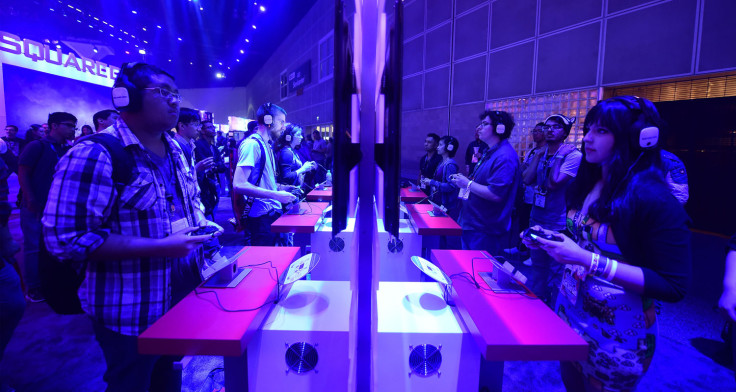E3 and other major expos highlight the problem of publicly exhibiting video games

I remember at a video game industry trade show, not dissimilar to E3, sitting down to test what was then the latest Assassin's Creed. Even with headphones on, I could barely hear it – the sound of the show floor and the other punters sat by me drowned out the game.
All the while, a queue of people, the next contingent of eager players, gazed at my screen from over my shoulder. I could hear them murmuring. Out of the corner of my eye, I could see two of them, pointing at the screen, going back and forth over the game's minutiae.
I played for maybe 10 minutes. The demo ended. I joined another hour-long queue for the next November blockbuster, and I wondered: is this the best way to exhibit video games? Is this the closest big games can get to a theatre, or a library? Can games even be enjoyed – thoroughly, respectfully – in public?
The nature of video games belies mass, cinema-like consumption: since everyone needs a controller and to be playing, sitting 400 people in an auditorium before a single giant screen is unworkable.
At the same time, it's ridiculous to imagine the idea of 'gamer' types, perhaps bespectacled and wearing tweed, idling around a metropolitan gallery space playing levels from Call of Duty.
Some games lend themselves to this kind of exhibition – multiplayer games, beat 'em ups, racers – but if story, relevance, substance and truth are the pivotal aspirations of gaming currently, the virtues that demand (and could probably earn, given a chance) public attention, there must be some manner of displaying them to the world, and with dignity. Some 50 consoles, all playing the same level of an upcoming blockbuster, surrounded by advertisements, in a giant convention centre scored by Wiz Khalifa does not say dignity.
But games are too long, or at least not straightforward enough, to be enjoyed or experienced the way one would a film, show or painting. By definition, playing a game requires a certain amount of perambulation. I consider Far Cry 2 one the best-written and most powerful video games ever, but at roughly 30 hours long, it could not possibly be appreciated outside of one's own living room. Standing up in a gallery, you could play, but not properly absorb that game.
Titles such as Glitchhikers, Off Peak and Sonic Dreams Collection, all very short, contained video games, might be well-served by a gallery-like space. I can imagine people sitting down in a large, white room to play Three Fourths Home. But still, the big console games, particularly the story-driven ones, are contrary to public exhibition – or at least public exhibition of a certain fashion. They're easy to exhibit as products and coming attractions, but not as whole, appreciable texts.
Arcades made video games seem like toys and follies. Shows like E3 make games look like consumer electronics. We have occasional exhibits of individually produced, bespoke art games and areas, like the National Video Game Arcade in Nottingham, dedicated to preserving and promoting various aspects of video game culture. But how do you get something like The Last of Us, which warrants attention from non-gamers, in front of non-gamers?

To the majority of people, shows like E3 are impenetrable and off-putting. They're expensive, they're busy, they're described using jargon and slang, dedicating so much to the gamer and very little to the non-gamer. They're terrible environments in which to play games. With people looking over your shoulder, music and show-floor ambience drowning out the sound and only small, brief chunks of game available, it's impossible to get a sense of or enjoy what you're controlling. But what the hell can you do differently?
Games are a solitary hobby. Far Cry 2, well-written though it is, is also specifically designed to be played, compulsively, by one person. It's a strange paradox, but by displaying that game out in public, not only would you fail to communicate its many qualities, you'd make it look awful – something it very much is not.
Without the equivalent of cinemas or galleries, games have become perfectly financially prosperous. And they've arguably risen in artistic estimation. It'd be easier now than it was 20 years ago to argue for games' worth, certainly as a pastime, possibly as a means of human expression. But E3 and similar events project such a rotten image of gaming. A lot of what they reveal about games is accurate – games are expensive, games are created and sold as consumer products – but such stigmas might dissipate if video games were displayed to the world differently.
E3 and shows like it, and games, exist in a feedback loop: games are promoted via trade shows, trade shows treat games like products, games are thus designed like products, and so on. Ignoring entirely the questions or credibility or broad public acceptance, if there were some more dignified, less greedy way to exhibit video games it could influence the ways in which games are considered and made.
Because as long as they're laid out in these kinds of troughs, to be quickly subsumed by one herd of people after another – sit down, headphones on, ten minutes, bring in the next lot – they'll seem, out in public, like slop.
For all the latest video game news follow us on Twitter @IBTGamesUK.
© Copyright IBTimes 2025. All rights reserved.



















